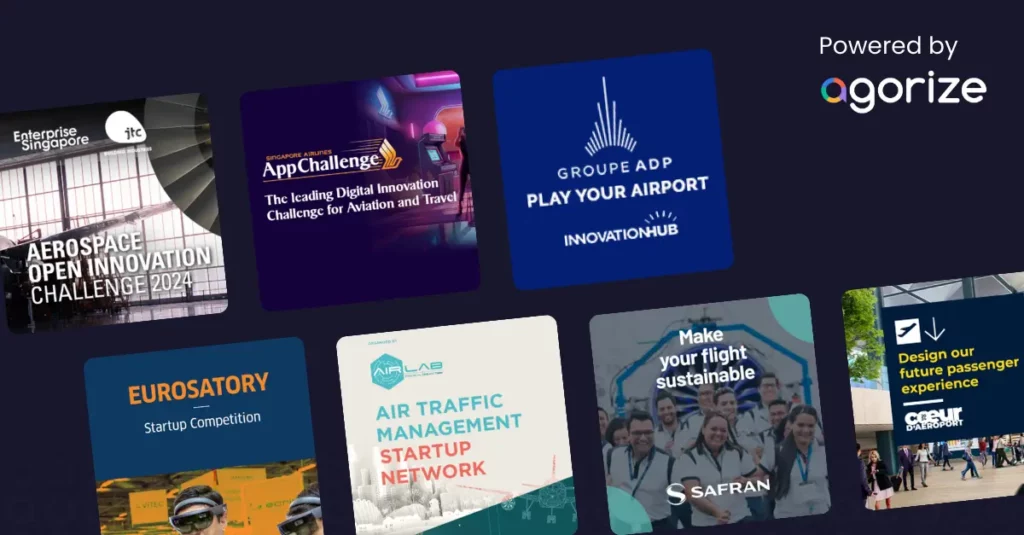The aerospace industry is one of the most technologically advanced and rapidly evolving sectors globally. Innovation leaders in aerospace constantly seek ways to stay relevant, adapt to emerging trends, and lead the charge in developing groundbreaking technologies. Whether at airlines, airports, or air traffic management companies, sustainable aerospace innovations are essential.
In 2024, the development of new technologies must be underlined with sustainable transformation. The aviation industry worldwide is committed to reducing carbon emissions, with many airlines and countries setting net zero targets for 2050. Almost 60% of aerospace and defense leaders see sustainability as a crucial topic to address across their operations over the next three years (Accenture). Only when innovative technologies and sustainable developments are adopted simultaneously, can companies create the future of aerospace.
This article offers insights into emerging aerospace technology trends and provides actionable ideas for maintaining a competitive edge.
The current landscape of aerospace innovations
The aerospace industry has always been at the forefront of technological advancements, driven by the need for improved safety, efficiency, and performance. In recent years, several key trends have emerged, shaping the future of aerospace and redefining what is possible. The trends include advanced satellite technology for global communications, additive manufacturing for lightweight components, and supersonic and hypersonic flight for faster travel. Spacecraft advancements have expanded deep space exploration and commercial space travel. These technologies drive efficiency, sustainability, and exploration in the aerospace industry.
Emerging technologies in aerospace
Emerging technologies such as artificial intelligence (AI), machine learning (ML), and the Internet of Things (IoT) are revolutionizing aerospace manufacturing and operations. These technologies enable smarter design processes, predictive maintenance, and enhanced operational efficiency. For example, AI-driven analytics can predict potential system failures before they occur, reducing downtime and maintenance costs.

Sustainability in the aerospace industry
The global aerospace industry is investing in renewable energy sources and energy efficiency measures to reduce their operational carbon footprints. The initiatives span airports, airlines, and air traffic managers.
Sustainability at airports
Airports are investing heavily in renewable energy and energy efficiency measures. Solar power deployment, clean energy airside vehicles, and building energy efficiency are key focus areas. For instance, air conditioning can account for up to 50% of energy consumption in some airports, making energy-efficient designs critical. Additionally, resource circularity is becoming a priority, aiming to minimize waste and promote recycling.
Airlines
Airlines are focusing on sustainable aviation fuel (SAF) and fleet renewal to reduce carbon emissions. International bodies like the International Air Transport Association (IATA) and the International Civil Aviation Organization (ICAO) advocate for the widespread use of SAF. Countries and regions, such as the European Union, have set mandates and targets for increasing the use of SAF. Fleet renewal involves replacing older aircraft with newer, more fuel-efficient models, further contributing to sustainability goals.
Air Traffic Management
Operational improvements in air traffic management (ATM) are essential for enhancing efficiency and reducing fuel burn. ICAO’s Global Air Navigation Plan includes measures to optimize flight paths and reduce delays, and regions like Europe are implementing advanced ATM technologies and concepts to achieve these goals.
Agorize and Starburst announce aerospace innovation partnership
We’re excited to announce an exclusive aerospace innovation offer from Starburst and Agorize that will get you actionable support through active program steering.
“We believe there is a significant opportunity for Starburst and Agorize to leverage their extensive expertise, digital platforms, and years of experience in supporting innovation and startups. By doing so, they can support companies navigate industry transformation and harness value-creating enabling technologies.
When well-managed and focused on outcomes, open innovation not only accelerates the development of cutting-edge technologies but also ensures that these innovations are aligned with market needs and sustainability goals. This approach enables companies to stay up to date on technology, offer new value for customers, or enter new markets.”
Our approach
1. Define your key transformation axes with the Starburst team
2. Scout and assess innovative solutions on Agorize’s innovation platform to address your specific challenges
3. Go further: Receive Starburst’s implementation support for large-scale deployment
Why join now? Experience an effortless innovation process where a unique combination of teams does the heavy lifting. Plus, reap benefits long after the initial project thanks to your newly acquired pool of innovative solutions to be accessed anytime.
How innovation platforms accelerate the aerospace industry
To stay relevant in the competitive aerospace industry, innovation leaders must focus on several key areas. Innovation platforms play a crucial role in this effort. By leveraging platforms like Agorize, companies streamline the innovation process, saving time and effort while accessing a pool of innovative solutions.
1. Continuous investment in aerospace innovations
Innovation platforms like Agorize streamline innovation processes, making it easier for companies to identify, develop, and implement new technologies. This reduces the time and resources required for internal R&D teams, allowing for continuous investment in new innovations. Additionally, these platforms connect aerospace companies with a global pool of innovators, bringing fresh perspectives and accelerating the development of cutting-edge technologies.
2. Focus on sustainability
Innovation platforms prioritize sustainability by encouraging the development of eco-friendly solutions. Programs focused on renewable energy, sustainable aviation fuel (SAF), and resource circularity attract innovators dedicated to reducing the environmental impact of the industry. By participating in these programs, companies can collaborate with like-minded organizations and experts, fostering the exchange of knowledge and best practices to develop effective sustainability strategies.
3. Embracing automation and AI
Innovation platforms support the integration of automation and AI by connecting companies with experts and startups specializing in these technologies. Programs focused on AI and automation help companies explore and implement advanced solutions that enhance efficiency, reduce costs, and improve overall performance. The structured approach provided by innovation platforms accelerates the adoption of AI and automation, reducing complexity and effort.
4. Leverage data analytics
Innovation platforms connect aerospace companies with innovators specializing in data analytics. As such, enabling them to access advanced analytics technologies that improve decision-making, optimize operations, and enhance overall efficiency. These platforms encourage the use of data analytics to drive innovation by leveraging data from various sources, providing valuable insights into customer preferences, market trends, and operational performance.
5. Foster a culture of innovation
Innovation platforms promote collaboration and creativity within organizations by encouraging employees to think creatively, experiment with new ideas, and collaborate with external innovators. They provide opportunities for continuous learning and development, helping employees stay updated on the latest trends and technologies. Additionally, these platforms include employee recognition and reward tools, motivating employees to contribute their best ideas and fostering a culture where innovation is valued and encouraged.

Case studies: Successful aerospace innovation programs
Agorize has collaborated with several leading groups in the aerospace industry on various innovation programs. They engaged employees, startups, and students to scout, assess, and implement innovative ideas and solutions to create more value.
The Aerospace Open Innovation Challenge
The Aerospace Open Innovation Challenge 2024 is a platform for startups to showcase their ideas and solutions for the aerospace industry. Participants from around the world submit proposals focused on emerging aerospace technology trends, propulsion systems, and advanced materials. The challenge fosters collaboration between established companies and startups, driving the development of innovative technologies. The participating companies include Airbus, GE Aerospace, Jet Aviation, RTX, ST Engineering, and Bell. The challenge is organized by Enterprise Singapore and JTC.
The Singapore Airlines AppChallenge
The Singapore Airlines AppChallenge invites startups and tech enthusiasts to develop solutions that enhance the passenger experience, streamline operations, and improve sustainability. This program highlights the importance of leveraging emerging technologies to address real-world challenges in the commercial aerospace sector.
The Groupe Aéroports de Paris Play Your Airport Challenge
The Play Your Airport Challenge engages students in developing innovative solutions to improve airport operations and passenger experience. By tapping into the creativity of young minds, this challenge encourages the development of practical and scalable solutions for the aerospace industry.
The Safran EGP Challenge
The Safran EGP Challenge focuses on emerging technologies in aerospace manufacturing and propulsion systems. Participants work on developing advanced materials and propulsion technologies that can enhance aircraft performance and reduce environmental impact.
The Thales Air Lab ATM Startup Network
The Air Lab ATM Startup Network connects startups with industry leaders to develop innovative solutions for air traffic management. This program emphasizes the importance of collaboration and innovation in improving the efficiency and safety of air traffic operations.
Conclusion
Staying relevant in the competitive aerospace industry requires a proactive approach to aerospace innovations. By embracing automation, sourcing new technologies, focusing on sustainability, leveraging data analytics, and fostering a culture of innovation, aerospace companies can maintain their competitive edge. Participating in open innovation challenges provides valuable opportunities to collaborate with innovators and drive the development of groundbreaking technologies.
The future of aerospace is bright, with emerging technologies and innovations poised to transform the industry. Stay informed about the latest trends and continuously seek ways to innovate. Those that create the future of aerospace are sure to lead it too.
Agorize has launched multiple aerospace innovation platforms for its clients:
– Enterprise Singapore: Aerospace Open Innovation Challenge
– Groupe Aéroports de Paris: Play Your Airport
– Safran: Make Your Flight Sustainable
– Eurosatory: Startup Competition
– Thales AirLab: Air Traffic Management Startup Network
– And more!
Innovation platforms help aerospace executives sustainably develop new technologies. Platforms help leaders:
1. Invest in aerospace innovations
2. Focus on sustainability
3. Embrace automation and AI
4. Leverage data and analytics
5. Foster a culture of innovation
Sustainable Aviation Fuel (SAF), airline fleet renewal, operational transformation, building energy efficiency, solar power deployment, and more.










